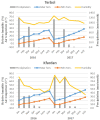The interaction between drought stress and nodule formation under multiple environments in chickpea
- PMID: 36301853
- PMCID: PMC9612560
- DOI: 10.1371/journal.pone.0276732
The interaction between drought stress and nodule formation under multiple environments in chickpea
Abstract
Environmental stresses, particularly drought, limit symbiotic nitrogen fixation in legumes, resulting in decreased yielding capacity. Drought is one of the most important constraints limiting yield potential in crops and it is the major abiotic stress that can cause more than 70% yield loss in chickpea. In this study, a total of two hundred four chickpea (Cicer arietinum L.) genotypes were selected to study the interaction between drought stress and nodule formation. This interaction was assessed by using morphological, yield and yield components. The field experiments were laid out in two locations (Terbol and Kfardan stations, Bekaa valley, Lebanon) using Alpha lattice design with two replications and two watering treatments (irrigation and rainfed) during 2016 and 2017 seasons. Parameters that were measured include days to 50% flowering (DFL), day to maturity (DM), plant height (PLH), nodule biomass (NB), nodule fresh weight (NFW), nodule dry weight (NDW), grain yield (GY), Biological yield (BY), 100 seed weight (100SW) and drought tolerance stress (DTS). The results indicated a significant variation between genotypes, environments and other morphological, yield and yield components traits. Drought stress reduced significantly the yield and the nodule's characteristics, biological and grain yield. The genotypes with the highest levels of drought tolerance, such as IG70399, IG8256, IG71832, IG70270, and IG70272, showed a minimal decrease in yield and nodule biomass. Nodule observations significantly and positively correlated with GY (0.36-0.38) under drought stress treatment. The correlation values for nodule characteristics with DFL and DM were higher under drought stress compared to irrigated conditions. This is a comparative study between drought stress and nodule formation traits associated with morphological, yield and yield components traits.
Conflict of interest statement
The authors have declared that no competing interests exist.
Figures
Similar articles
-
Selection of high nitrogen fixation chickpea genotypes under drought stress conditions using multi-environment analysis.Front Plant Sci. 2025 Apr 7;16:1490080. doi: 10.3389/fpls.2025.1490080. eCollection 2025. Front Plant Sci. 2025. PMID: 40260431 Free PMC article.
-
Selection and screening of drought tolerant high yielding chickpea genotypes based on physio-biochemical indices and multi-environmental yield trials.BMC Plant Biol. 2020 Apr 17;20(1):171. doi: 10.1186/s12870-020-02381-9. BMC Plant Biol. 2020. PMID: 32303179 Free PMC article.
-
Transgenic chickpea (Cicer arietinum L.) harbouring AtDREB1a are physiologically better adapted to water deficit.BMC Plant Biol. 2021 Jan 11;21(1):39. doi: 10.1186/s12870-020-02815-4. BMC Plant Biol. 2021. PMID: 33430800 Free PMC article.
-
A Comprehensive Review on Chickpea (Cicer arietinum L.) Breeding for Abiotic Stress Tolerance and Climate Change Resilience.Int J Mol Sci. 2022 Jun 18;23(12):6794. doi: 10.3390/ijms23126794. Int J Mol Sci. 2022. PMID: 35743237 Free PMC article. Review.
-
Growth-defence carbon allocation is complementary for enhanced crop yield under drought and heat stress in tolerant chickpea genotypes.J Plant Physiol. 2025 Apr;307:154473. doi: 10.1016/j.jplph.2025.154473. Epub 2025 Mar 8. J Plant Physiol. 2025. PMID: 40086341 Review.
Cited by
-
Engaging Precision Phenotyping to Scrutinize Vegetative Drought Tolerance and Recovery in Chickpea Plant Genetic Resources.Plants (Basel). 2023 Aug 4;12(15):2866. doi: 10.3390/plants12152866. Plants (Basel). 2023. PMID: 37571019 Free PMC article.
-
Index-Based selection of Chickpea (Cicer arietinum L.) genotypes for enhanced drought tolerance.Sci Rep. 2025 Mar 10;15(1):8282. doi: 10.1038/s41598-025-93273-1. Sci Rep. 2025. PMID: 40064990 Free PMC article.
-
Genome-wide association study reveals SNP markers controlling drought tolerance and related agronomic traits in chickpea across multiple environments.Front Plant Sci. 2024 Mar 8;15:1260690. doi: 10.3389/fpls.2024.1260690. eCollection 2024. Front Plant Sci. 2024. PMID: 38525151 Free PMC article.
-
Prioritization of Physio-Biochemical Selection Indices and Yield-Attributing Traits toward the Acquisition of Drought Tolerance in Chickpea (Cicer arietinum L.).Plants (Basel). 2023 Sep 5;12(18):3175. doi: 10.3390/plants12183175. Plants (Basel). 2023. PMID: 37765339 Free PMC article.
-
Selection of high nitrogen fixation chickpea genotypes under drought stress conditions using multi-environment analysis.Front Plant Sci. 2025 Apr 7;16:1490080. doi: 10.3389/fpls.2025.1490080. eCollection 2025. Front Plant Sci. 2025. PMID: 40260431 Free PMC article.
References
-
- Rome I. Food and Agriculture Organization of the United Nations. Durham, USA: Duke University. 2020;.
-
- Erman M, Demir S, Ocak E, Tüfenkçi Ş, Oğuz F, Akköprü A. Effects of Rhizobium, arbuscular mycorrhiza and whey applications on some properties in chickpea (Cicer arietinum L.) under irrigated and rainfed conditions 1—Yield, yield components, nodulation and AMF colonization. Field Crops Research. 2011;122(1):14–24. doi: 10.1016/j.fcr.2011.02.002 - DOI
-
- Kumar J, Abbo S. Genetics of flowering time in chickpea and its bearing on productivity in semiarid environments; 2001.
Publication types
MeSH terms
LinkOut - more resources
Full Text Sources


